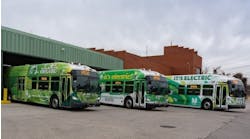The Stark Area Regional Transit Authority's (SARTA) drive to become a national leader in the use of zero-emission technology reached another milestone today when the first of ten Hydrogen Fuel Cell-powered buses SARTA will acquire over the next two years was unveiled at the Ohio Statehouse in Columbus, OH. Under the terms of an agreement between SARTA and The Ohio State University, the new bus will be operated on the Columbus campus by the university's Department of Transportation and Traffic Management as part of the Campus Area Bus Service (CABS) for the next 12 months. The unique arrangement will enable Ohio State's Center for Automotive Research (CAR), a nationally-recognized leader in interdisciplinary automotive research, to collect important data on the vehicle's performance in everyday use on campus streets.
During the next year, the bus will travel throughout the Columbus campus with an exterior design that highlights the technology. CABS will provide basic maintenance for the bus, including tire and oil changes, for the duration of the test period.
When all ten vehicles join its fleet, SARTA will become the third largest operator of fuel cell buses in the United States and the largest outside California. The unveiling ceremony was held in conjunction with the Ohio Public Transportation Association's (OPTA) Annual Conference.
The second of the ten vehicles will be delivered to the Altoona Bus Testing and Research Center in Altoona, PA. The Center, operated by Penn State University's Thomas D. Larson Pennsylvania Transportation Institute performs federally-mandated performance evaluations of all new bus models. The vehicle will be put into service in Stark County when testing is completed. All ten buses will join SARTA's fleet in 2017 and 2018.
"While we'd obviously like to add the buses to our fleet today, our willingness to engage in this type of research and testing is one of the primary reasons we were able to obtain the federal and state funding that is paying for the entire cost of the first two vehicles," SARTA Executive Director/CEO Kirt Conrad said "Under normal circumstances, we would have had to come up with a 20% local match to purchase the buses. The Federal Transportation Administration (FTA) match is not required because we're allowing Ohio State and Penn State to test them. That saved us more than $1.6 million dollars."
These two buses were funded under FTA's National Fuel Cell Bus Program, in partnership with Calstart of Pasadena, CA, which requires a 50% in-kind contribution. Additionally, the partners for building the bus, El Dorado, Ballard Power Systems and BAE, have also contributed to the in-kind match.
The remaining eight buses were funded under FTA's No and Low Emission program. Five buses were funded in 2015. Last week, Senator Brown announced the award of funding for three additional buses.
Conrad said the fuel cell project underscores SARTA's proven ability to identify state-of-the-art transit technology and secure the millions of dollars in state and federal funding needed to acquire and deploy it. "While we've become a nationally-recognized leader in the use of low and zero-emission fuels and the adoption of advanced rider tools like PinPoint and Google Transit we've never lost focus on or been diverted from meeting the day-to-day transportation needs of Stark County residents," he said.
"We've been able to simultaneously embrace innovation, enhance services for veterans, students and the disabled and add new routes--all while holding the line on fares and local taxes," Conrad said. "That's why so many people believe SARTA is one of our community's most valuable assets."
Conrad said SARTA decided to actively participate in the hydrogen fuel cell "revolution" for a number of reasons. "Along with enabling us to cut our fuel costs by as much as fifty percent in the years ahead and maintain our position as trailblazers in the use of green technology to fuel public transit, this project will drive investment, research, business development and job creation in Stark County and across our state," he said. "Honda, Worthington Industries, LG Fuel Cell Systems, Swagelok and other Ohio companies as well as universities including Ohio State, Stark State and Cleveland State University, are heavily involved and invested in fuel cell and hydrogen-related manufacturing and R & D projects," Conrad said.
SARTA wants to be at the forefront of commercializing this technology because transit systems, businesses and private citizens will begin to utilize fuel cell-powered vehicles featuring components and technology developed and manufactured in Stark County and other parts of the state. Once hydrogen is better understood people will see that it is a practical, safe, cost-effective and environmentally friendly alternative to traditional fuels," Mr. Conrad said. "Our partnership with Ohio State, as well as the support we've received from federal and state officials, will ensure that our state is the focal point of what will undoubtedly be a growing and dynamic industry."
Conrad did his part to foster the critically important perception that hydrogen fuel cells are safe by consuming the only substance emitted from the tail pipe of vehicles powered by them: Water.
"We couldn't think of a clearer way to illustrate exactly what 'zero emissions' means," he said. "What better way to illustrate how fuel cell buses make our air cleaner, than by drinking the water they emit."


